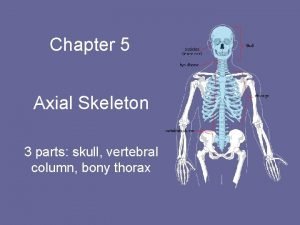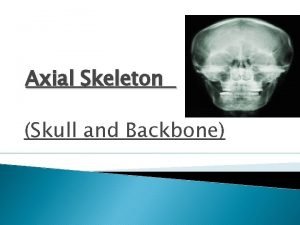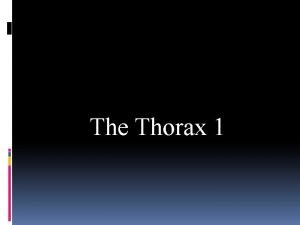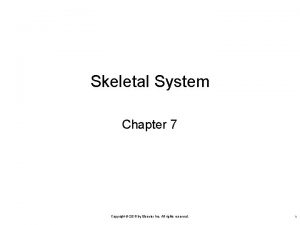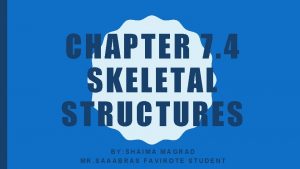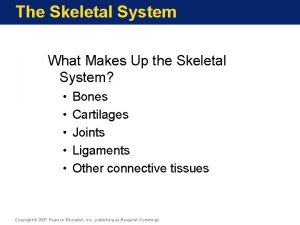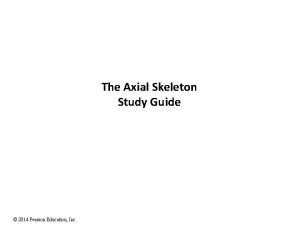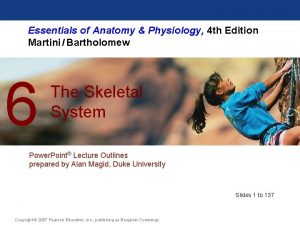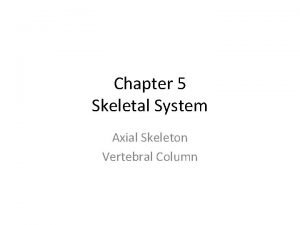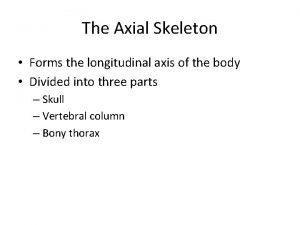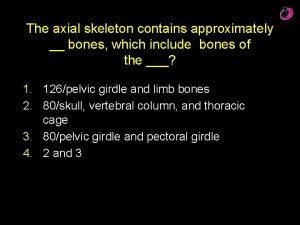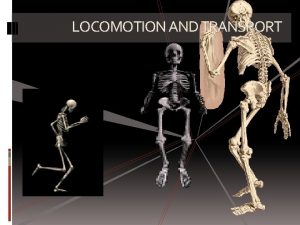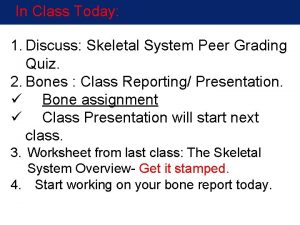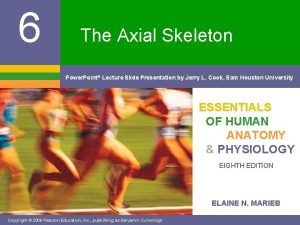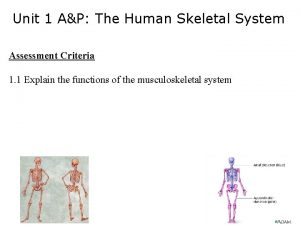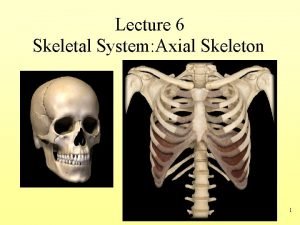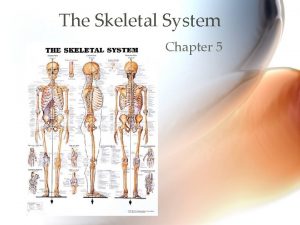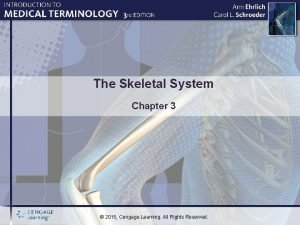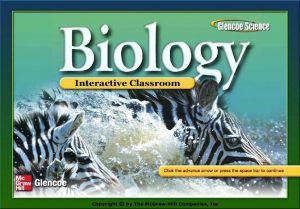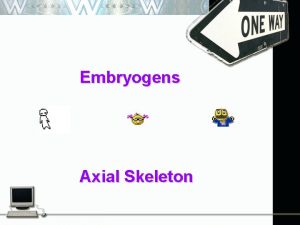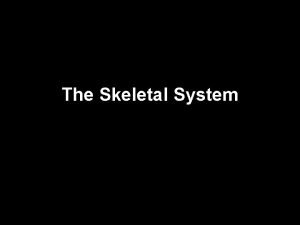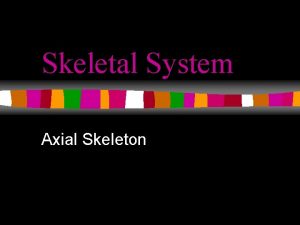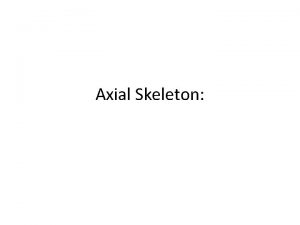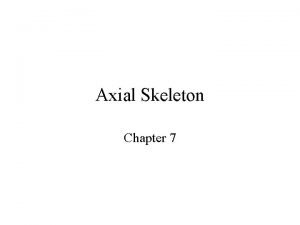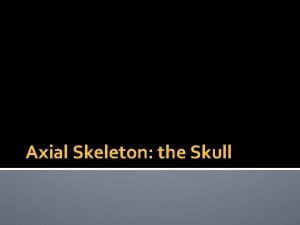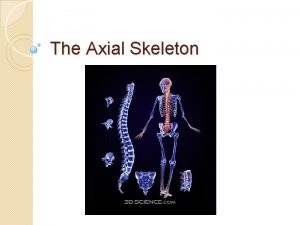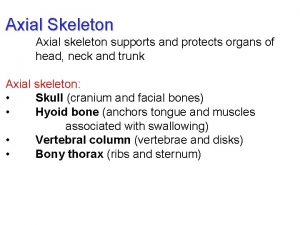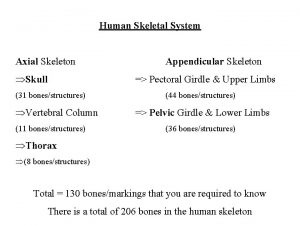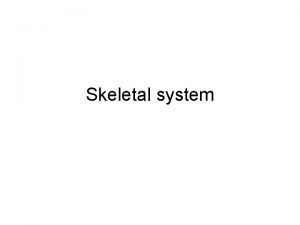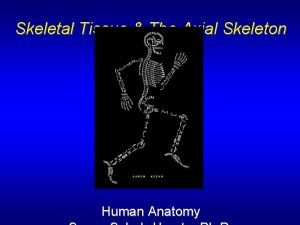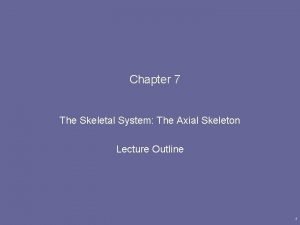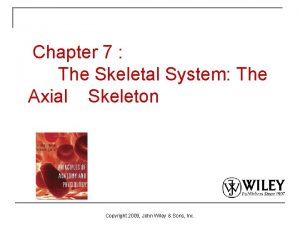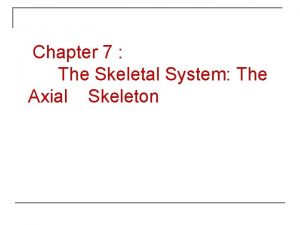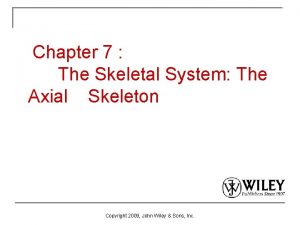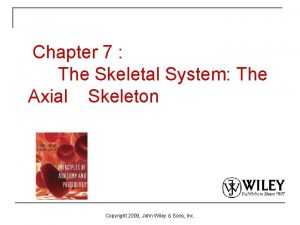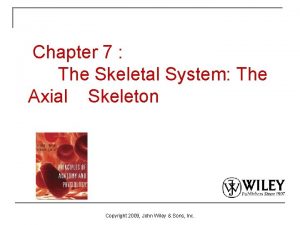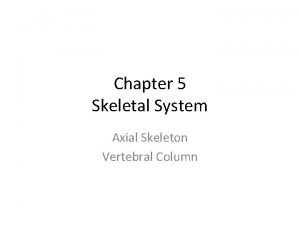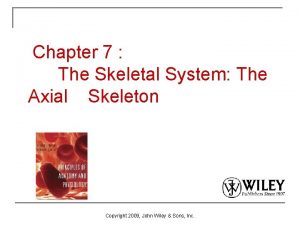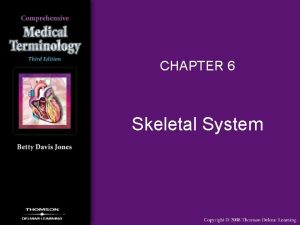Chapter 7 The Skeletal System The Axial Skeleton


























- Slides: 26

Chapter 7 The Skeletal System: The Axial Skeleton 1

Chapter 7 Skeletal System Gross Anatomy 7 -2

Skeletal System • Provides framework • Without skeleton, muscles couldn’t move body • Components – – Bones Cartilage Ligaments Tendons • Relationships among bones and soft tissues 7 -3

Skeleton • Axial skeleton – Skull – Hyoid bone – Vertebral column – Thoracic (rib) cage • Appendicular skeleton – Limbs – Girdles 7 -4

The Complete Skeleton 7 -5

Anatomic Bone Features • Terms – Body: Main part – Head: Enlarge end – Neck: Constriction between head and body – Margin or border: Edge – Angle: Bend – Ramus: Branch off body – Condyle: Smooth rounded articular surface – Facet: Small flattened articular surface • Projections – Process: Prominent projection – Tubercle: Small rounded bump – Tuberosity: Knob – Trochanter: Tuberosities on proximal femur – Epicondyle: Near or above condyle 7 -6

Anatomic Bone Features • Ridges – Line or linea: Low ridge – Crest or crista: Prominent ridge – Spine: Very high ridge • Openings – – Foramen: Hole Canal or meatus: Tunnel Fissure: Cleft Sinus or Labyrinth: Cavity • Depressions – Fossa: General term for a depression – Notch: Depression in bone margin – Fovea: Little pit – Groove or sulcus: Deeper, narrow depression 7 -7

The Skull or Cranium • Functions – Protects brain – Supports organs of special senses – Provides foundation for structures that take air, food , water into body • Superior view of skull – – Parietal bones Frontal bone Sagittal suture Coronal suture 7 -8

Posterior View of Skull • • Occipital bone Lambdoid suture Sutural bones External occipital protuberance – Ligamentum nuchae: Helps keep head erect – Nuchal lines: Neck muscle attachment points 7 -9

Lateral View of Skull • Squamous suture • External auditory meatus • Mastoid Process • Temporal lines • Sphenoid bone • Zygomatic bones • Maxilla • Mandible 7 -10

Frontal View of Skull • • • Frontal bone Zygomatic bones Maxillae Mandible Orbits – Nasolacrimal canal – Optic foramen 7 -11

Bones of Nasal Cavity 7 -12

Paranasal Sinuses • Functions – Decrease skull weight – Resonating chambers • Names – – Frontal Maxillary Ethmoidal Sphenoidal 7 -13

Inferior View of Skull • • • Foramen magnum Occipital condyles Jugular foramina Styloid processes Vomer bone Hard or bony palate 7 -14

Hyoid Bone • Unpaired • No direct bony attachment to skull • Attachment point for some tongue muscles • Attachment point for neck muscles that elevate larynx during speech and swallowing 7 -15

Vertebral Column • • • Supports weight of head and trunk Protects the spinal cord Allow spinal nerves to exit the spinal cord Provides site for muscle attachment Permits movement of head and trunk 7 -16

Vertebra • • Body Vertebral foramen Vertebral arch Pedicle Lamina Transverse process Spinous process Articular processes 7 -17

Intervertebral Disks • Located between adjacent vertebrae • Functions – Provide support – Prevent vertebrae rubbing • Consist of – Annulus fibrosus – Nucleus pulposus 7 -18

Herniated or Ruptured Disk 7 -19

Spina Bifida 7 -20

Vertebral Column • Regions – – – Cervical (7 vertebrae) Thoracic (12 vertebrae) Lumbar (5 vertebrae) Sacral bone (1) Coccygeal bone (1) • Major Curvatures (4) • Abnormal curvatures – Lordosis – Kyphosis – Scoliosis 7 -21

Cervical Vertebrae • Atlas – First vertebra • Axis – Second vertebra – Dens or odontoid process • Vertebral prominens 7 -22

Thoracic and Lumbar Vertebrae 7 -23

Sacrum and Coccyx 7 -24

Thoracic or Rib Cage • Functions – Protects vital organs – Forms semi-rigid chamber for respiration • Parts – Thoracic vertebrae – Ribs (12 pair) • True or Vertebrosternal • False or Vertebrochondral • Floating or vertebral – Sternum 7 -25

Sternum • Breastbone • Parts – Manubrium – Body – Xiphoid process • Sternal angle – Important landmark for counting ribs to locate areas of the heart 7 -26
 Chapter 5 axial skeleton worksheet answers
Chapter 5 axial skeleton worksheet answers Receive
Receive Appendicular vs axial bones
Appendicular vs axial bones Axial vs appendicular
Axial vs appendicular Axial vs appendicular skeleton
Axial vs appendicular skeleton Chapter 7 skeletal system
Chapter 7 skeletal system Chapter 7:4 skeletal system
Chapter 7:4 skeletal system Differentiate between axial and appendicular skeleton
Differentiate between axial and appendicular skeleton Figure 6-2 structure of a typical bone
Figure 6-2 structure of a typical bone Structural and functional classification of joints
Structural and functional classification of joints Axial skeleton study guide
Axial skeleton study guide Figure 6-4 the skeleton axial and appendicular divisions
Figure 6-4 the skeleton axial and appendicular divisions Lamina bone
Lamina bone Figure 5-13 is a diagram of the articulated skeleton
Figure 5-13 is a diagram of the articulated skeleton The axial skeleton contains
The axial skeleton contains What are the five functions of the skeletal system
What are the five functions of the skeletal system Concept map bones of the pelvic girdle
Concept map bones of the pelvic girdle Figure 6-4 the skeleton axial and appendicular divisions
Figure 6-4 the skeleton axial and appendicular divisions Lacrimal bones
Lacrimal bones Axial skeleton vertebral column
Axial skeleton vertebral column Axial skeleton
Axial skeleton Axial skeleton
Axial skeleton Skeletal system
Skeletal system Chapter 3 skeletal system kaplan answer key
Chapter 3 skeletal system kaplan answer key Chapter 5 the skeletal system figure 5-13
Chapter 5 the skeletal system figure 5-13 Chapter 6 skeletal system
Chapter 6 skeletal system Chapter 32 section 2 the skeletal system answer key
Chapter 32 section 2 the skeletal system answer key

